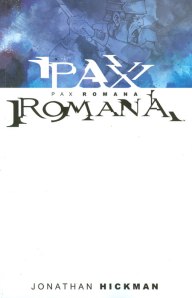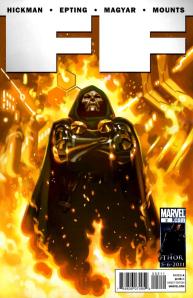I started this post some months ago and shelved it. I really had a problem talking Hickman. I’m not sure why, but I found it hard to quantify the works of this writer. Having just finished the first volume of The Manhattan Projects, I thought I would give it another go.
In a fairly short span of time Jonathan Hickman’s body of work has become an impressive statement of his creativity and deep reservoir of ideas. I first found his work with The Nightly News, a masterpiece of dark cynicism about the state of modern information and how it is disseminated to the peasants and livestock. Six issues starting in 2006, this book is very much a sort of “the revolution will be televised” kind of idea. With a dark path of media fuelled chaos, this book was not a happy read, but I could not put it down. I found myself uncomfortable with what I was reading, and not just because my inner anti-social misanthrope was clawing to get out in response to the story. This book hits uncomfortably close to home in many ways. There is much made up whole cloth, but just as much that is right from our daily lives, and it is often hard to separate the two, a theme or stylistic choice that presents itself in much of Hickman’s work. This book was Hickman as one man band. He wrote drew and designed the package and that same design sensibility inform his entire group of creator owned books from Image.
So I started looking for his other Image books. Having met him at C2E2 as Red Mass for Mars was starting up; I jumped to that one first. Another very strong book with a dark theme, this was a very nicely put together and well-drawn book. For this one, Ryan Bodenheim handled the art duties, but Hickman’s design sense is all over this. I found this more accessible as a story. It is more straightforward in its narrative and presented as more of a traditional panel-to-panel format than Nightly News was. Next for met was Pax Romana, a book heavy with religious themes and science fiction, this one tells the story of a Vatican funded time travel exhibition to “fix” the world by altering the past with a decidedly one-sided view of the world. Another wonderfully realized story, shorter at only 4 issues but just the right length and again, filled with Hickman’s design prerogatives and choices. This is a beautiful book to looks at and a good and slightly challenging read. The time travel aspect is well realized here and there is a strong sense of character and the book flows and evolves by the force of the characters.
In the time-travel theme, I was less happy with The Red Wing. This felt like a sort of Star Wars with a Star Trek flavored time-travel story. The book felt forced, like there was a great idea at its genesis, but they failed to flesh it out completely, but kept going anyway. Even Hickman’s less well executed works have a leg up on much of what is out there. Transhuman fared much better in its execution and was again a more traditional comic book formatted style.
The Manhattan Projects is the most recent work from Image (Feel Better Now has been delayed for a while). An ongoing series, the first 5 issues are now collected in TPB form and read very well in a single sitting. The dark tone is again a strong force here. This is something of a straightforward, if many layered, “what if…?” story, and it is meaty stuff. Heavy on the sci-fi elements, while set in the very real WWII era race for the atomic bomb and other weapons, this book is not fully realized yet, given that it is an ongoing, that is not surprising, but I wonder how many issues are planned. At this point it seems that this is a book that could run out of steam very quickly.
 Then there is his work for Marvel. He changed the face of the Fantastic Four, and by that I mean he made it a good book again for the first time in a while. There are only a handful of writers that have understood what makes this book work since Stan and Jack left and he is the most recent. I have no real hope that the book will be enjoyable once he is gone in a couple of issues from that and the newer FF title. The story he has crafted in Fantastic Four for the last few years has been astounding and fresh. It is always a surprise and never feels like he is repeating himself or others. He has stripped the book of much of its recent messy plot points and retained only the ideas from the past he can use. But he does it without retconning or negating any of the other points he chose not to use. In that he shows a respect for not just past writers, but the readers as well. While the FF book has not fared as well in the last few issues, and appears that it will wind down to something of an anti-climax, it has still been a strong book. It just pales next to the regular title. The plot threads in both books have touched on another Marvel book he has done, S.H.I.E.L.D. There have been significant delays in the second arc of the story, and I have my doubts we will ever see the 2 final issues. The collection is still listed at Amazon though, despite the book being unfinished. I presume that the title is canon, and so his insertion of key elements of the Marvel U into the distant past (Galactus coming to earth in the Italian renaissance) has been inspired and never felt stupid, as so many retcons have. Marvel is terrible at them generally, and they usually leave the readers feeling cheated or slighted in some way.
Then there is his work for Marvel. He changed the face of the Fantastic Four, and by that I mean he made it a good book again for the first time in a while. There are only a handful of writers that have understood what makes this book work since Stan and Jack left and he is the most recent. I have no real hope that the book will be enjoyable once he is gone in a couple of issues from that and the newer FF title. The story he has crafted in Fantastic Four for the last few years has been astounding and fresh. It is always a surprise and never feels like he is repeating himself or others. He has stripped the book of much of its recent messy plot points and retained only the ideas from the past he can use. But he does it without retconning or negating any of the other points he chose not to use. In that he shows a respect for not just past writers, but the readers as well. While the FF book has not fared as well in the last few issues, and appears that it will wind down to something of an anti-climax, it has still been a strong book. It just pales next to the regular title. The plot threads in both books have touched on another Marvel book he has done, S.H.I.E.L.D. There have been significant delays in the second arc of the story, and I have my doubts we will ever see the 2 final issues. The collection is still listed at Amazon though, despite the book being unfinished. I presume that the title is canon, and so his insertion of key elements of the Marvel U into the distant past (Galactus coming to earth in the Italian renaissance) has been inspired and never felt stupid, as so many retcons have. Marvel is terrible at them generally, and they usually leave the readers feeling cheated or slighted in some way.
As a group, Hickman’s books have many features in common. He seems to like the story under the story. Not so much tradition comic book subplots as much as underpinnings to the larger arc. Very often there will be clues in the story that don’t pay off for a very long time. There are a lot of influences, intentional or otherwise that feel like Warren Ellis or Alan Moore, and if he is aware of them, they are not so overt as to be distracting. Hickman’s stories are his own, never feeling like they could have come from someone else’s pen.
If you have not read any of these, they are all excellent and worth a read. If traditional comics have been your bag, the FF and Fantastic Four books are very worth it. If you want to be challenged on several levels, his Image work is a strong group of books to get you mind moving.





